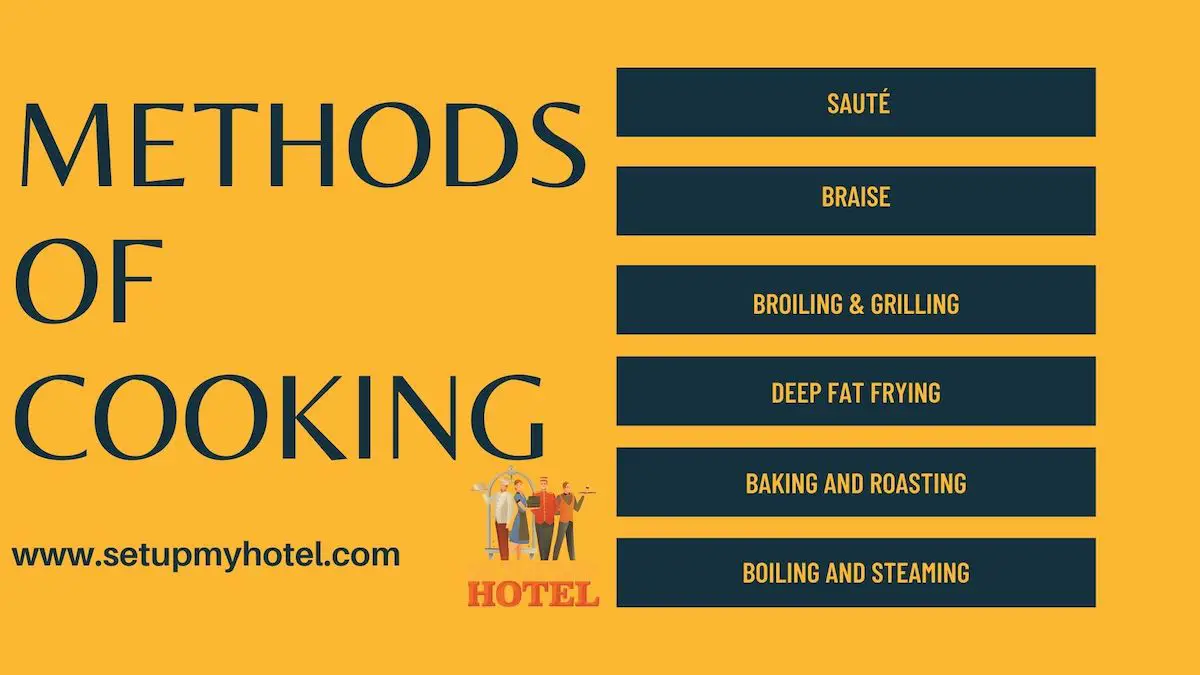Six Main Methods Of Cooking
Cooking methods vary widely, each offering a unique approach to preparing food. The act of cooking food is an essential part of everyday life. Cooking methods can range from boiling water to grilling a steak. There are many different ways to cook food and it is up to the cook to find the method that best suits their needs.
Here are six main methods of cooking
1. Sauté
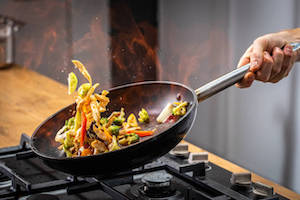
The word SAUTE is French for “to jump.” You must limit the amount of food in the pan so that you may control or flip the food. The purpose of sautéing is to cook the food quickly, to avoid the extraction of water and the oxidization of vitamins, but also to enhance the robustness of the meals and enhance their flavor.
The heat is sufficiently high to permit browning to occur and flavor to develop. There is, also, a small amount of fat in the pan to wick away the ingredients and to prevent food from sticking to the pan.
Sautéing will sear the outside of the meal, allowing the water to remain inside. This water will collect heat as it passes through the seared barrier and conduct it into the product’s core. There, it will cook or denature animal proteins, as well as soften vegetable tissues. As you can see, this must be done fast to preserve the nutritional integrity of the meal while also ensuring optimal browning and/or taste development.
2. Braise
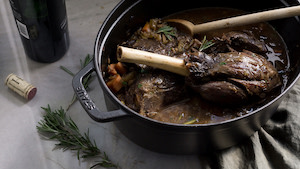
BRAISING is generally done at a lower temperature than sautéing, on the whole. The meat and vegetable ingredients are usually much larger. When braising, the foodstuffs are often seared first in hot fat to mitigate the loss of moisture and flavor during the cooking process. This also allows the surface of the meats and vegetables to brown and form flavor compounds that will determine how the taste will turn out.
When the meat is seared and browned and liquid and/or vegetables are added, the casserole is finished in a stew pot at about 210 degrees, or the meat is cooked in the liquid until its coagulated connective tissue breaks down.
When the process is complete, the connective tissue has turned into a portion of the sauce and will permit the sauce made from the braising liquid to develop a gelatin shininess. The meat is tender and extremely juicy in the water absorbed.
3. Broiling & Grilling
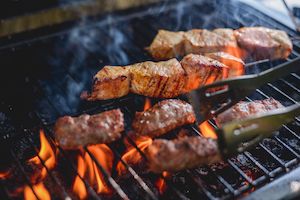
These cooking methods are essentially the same, with the only difference being gravity. Both methods depend on heat transfer via heat to heat food. The primary flavor compounds are created during the heating of the food and marinade before cooking it.
Like sauté, the heating system in the food advances from its exterior to its core through conduction, The more tender cuts of meat are utilized as these, as they lack any connective tissue.
- Description: Grilling involves cooking food directly over an open flame or heat source. It’s commonly done outdoors on a barbecue or grill.
- Examples: Grilled meats, vegetables, kebabs, and seafood.
- Benefits: Imparts a distinct smoky flavor, creates grill marks, and cooks food quickly.
4. Deep Fat Frying
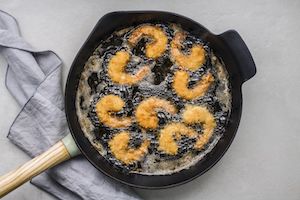
This set of procedures is at the same time complex and extremely simple. It is complex because it needs to follow a set of rules, but beyond that, you can fry nearly anything, including ice cream. The maintenance of the water is effortless at 212 degrees Fahrenheit, but oil cannot be maintained without a thermometer and an even heat source.
The oil must be carefully shielded from the food while it is being fried and the food from that oil. Volatile water from the food will always seep during frying, but if too much of this water evaporates, it will dry the food out and spoil your oil. Applying a coating to the fried food will protect that oil and absorb extra moisture. Furthermore, water losses from the food will be greatly reduced.
The best-tasting deep-fried foods are specifically confined in the container in which they were fried by the heat of the frying oil. These are then cooked using their own steam, which is generated by the frying oil’s heating element.
5. Baking And Roasting
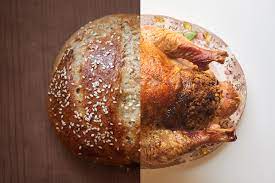
BAKING is the cooking of food with dry heat around what you’re cooking. Oven baking is a form of delivering heat evenly on all sides of a food base so that all parts of that food are cooking simultaneously. This is in contrast to roasting, in which a lower temperature is used and the term baking includes different kinds of food aside from meat.
ROASTING, on the other hand, is the practice of cooking meats at sufficiently high temperatures that the browning process is greatly expedited on the surface. This is possibly due to the amount of protein found in the meat and amino acids, but also due to the fats there. There are fewer sugars than, say, in a piece of cake, but they react at high temperatures to cause the wonderful scent of browning.
- Roasting is a dry-heat cooking method that involves cooking food in an oven. It’s often used for larger cuts of meat or whole poultry. Similar to roasting, baking is a dry-heat cooking method conducted in an oven. It’s commonly used for bread, pastries, and casseroles.
- RoastRoast - To cook food by surrounding it with dry heat. chicken, turkey, beef roasts, and vegetables. Develops a golden brown exterior, enhances flavors through caramelization, and retains moisture.
- Baked goods, casseroles, lasagna, and cookies. Promotes even cooking, creates a crisp or tender texture, and allows for the development of various textures and flavors.
6. BoilingBoiling - A moist heat cooking method that uses convection to transfer heat from a hot (approximatel... And Steaming
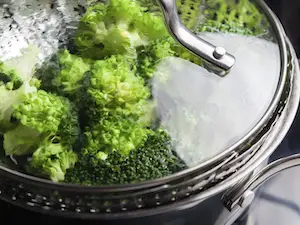
Boiling water reaches a maximum temperature of 212°F, the closer you are to that temperature, the more agitated the food becomes. This results in food becoming broken and unattractive. For this reason, the food is hardly ever boiled. Instead of being pulled out of the boiling e-mail, it is simmered at a lower temperature or steamed at a higher one.
STEAMING of foods can reach higher cooking temperatures without the agitation of boiling. The use of steam under pressure makes it possible to reach the cooking temperatures used in deep frying and baking.
Steaming under pressure can attain exceedingly high temperatures since there is no air on board the appliance. On the flip side, too much pressure is detrimental when you want to cook because the food is too compressed. Lower pressure is observed most often. One of the drawbacks is that, in a commercial steamer, it is challenging to observe the food as you are cooking so overcooking might be likely.
- Description: Boiling involves cooking food by submerging it in a boiling liquid, typically water. It’s commonly used for pasta, rice, vegetables, and proteins.
- Examples: Boiled eggs, pasta, rice, and vegetables.
- Benefits: Cooks food quickly, retains nutrients, and is a simple method for many ingredients.
Controlling the distribution of the heat necessary for food preparation is an absolute requirement of successful cooking. Accurate application of this control results in exceptional, delicious food. When this quality isn't maintained, all other efforts are squandered.
